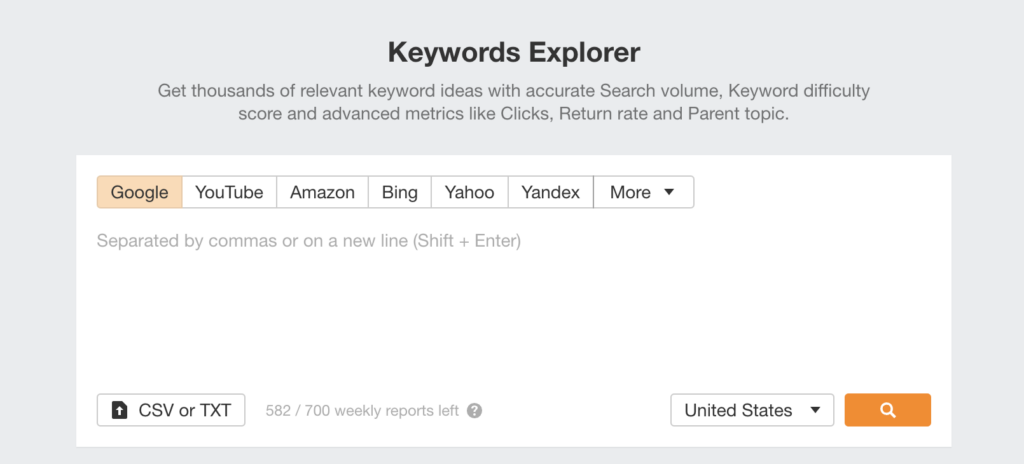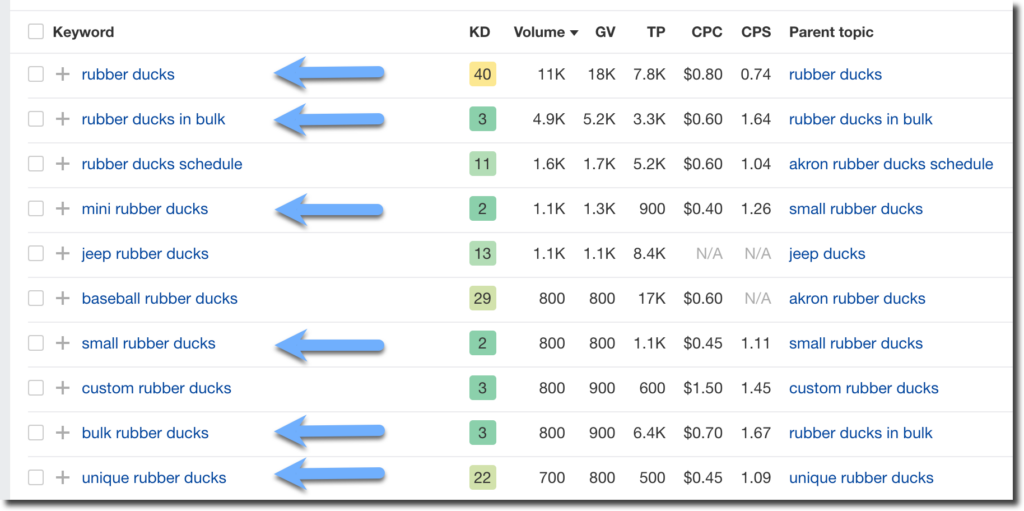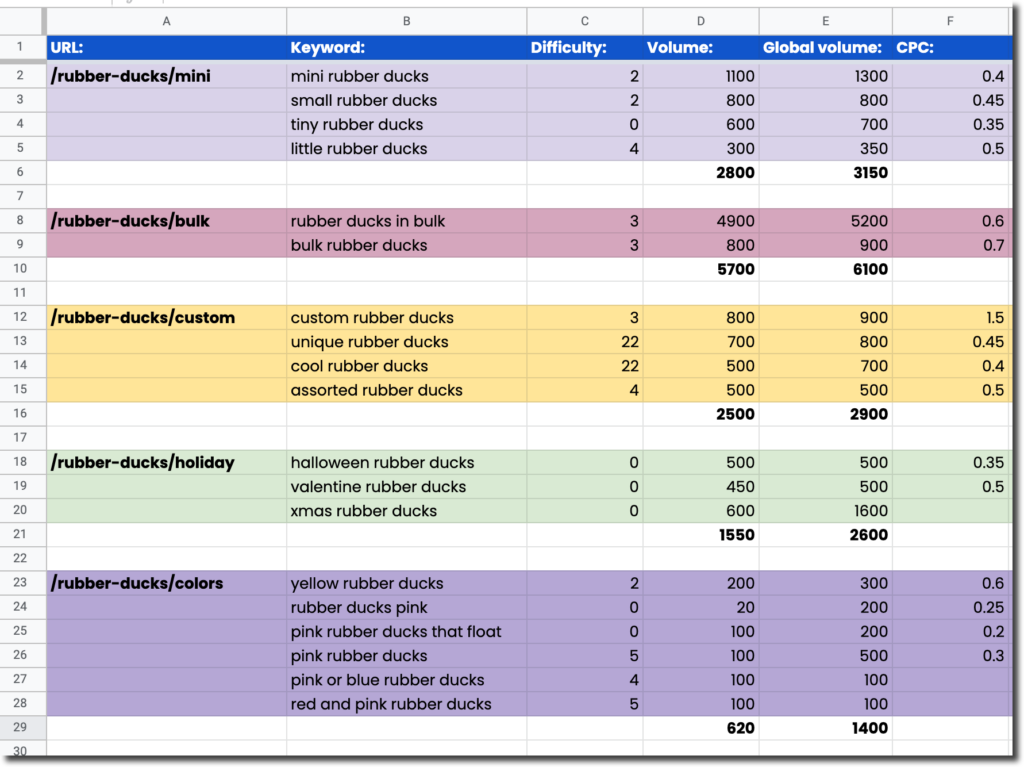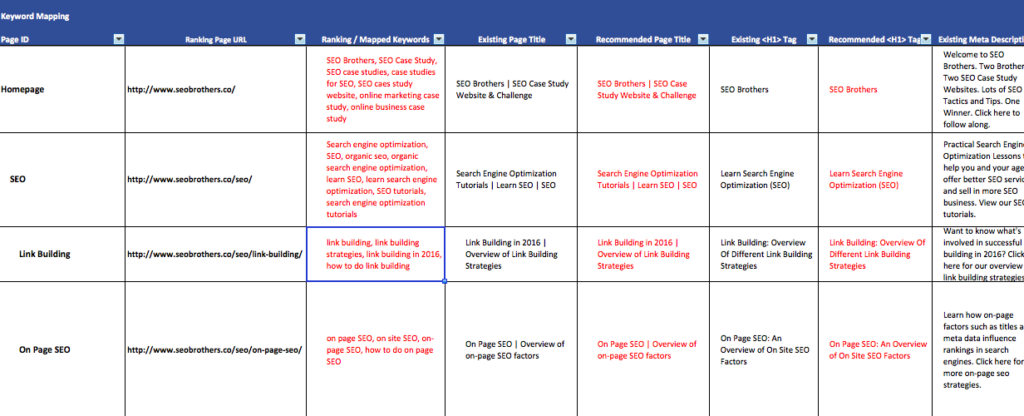To begin with the obvious, SEO revolves heavily around keywords. What people search for, how often they search, and how difficult it will be to rank for a target term are all concepts that we consider when completing keyword research. As SEOs, we comb through data, look at trends, and ultimately pare down an unwieldy list of keywords into actionable targets. Identifying what terms to rank for, how they’re currently ranking, and if/how/why/when that changed, is all part of the game.
One crucial aspect of keyword research that is often neglected—or just misunderstood—is that of keyword mapping. Whether you’re new to SEO or an established veteran, the concept of keyword mapping is equally valuable to maintain and convey an accurate understanding of the state of your website in organic search, and how it can be improved.
Read on to learn about what keyword mapping is and how to do it right.
What Is Keyword Mapping?
At its most basic form, a completed keyword mapping deliverable is a spreadsheet that correlates URLs on your site to the target keywords associated with them—whether extant or yet to come. It is a lovely visual representation of these keywords and illustrates where they belong within the pages of your site. Keyword mapping will enable you to create better content, optimize existing landing pages, and gain a better understanding of your site’s organic strategy as a whole.
A keyword mapping document can reveal critical aspects of the site. We’re provided a better understanding of its structure and can better discern priorities for optimization. Take, for example, the image below—this process will illuminate the opportunities in the center of the diagram.
We’ll get into why exactly this process is so important—and valuable—a little later on.
When To Do Keyword Mapping
There are many situations in which creating an accurate keyword map will greatly strengthen your organic strategy and inform your roadmap moving forward. Rather than making the blanket statement that it’s “always a good idea” (which to some degree, it must be said, is true) let’s examine a few more concrete situations:
Keyword mapping to identify new content opportunities:
If you’re ideating new content for your website, you can establish ahead of time the exact purpose of each new page as it relates to target keywords and rankings. Keyword mapping before content creation is also extremely beneficial in identifying content overlap. If a proposed page has a central theme that’s already targeted by keywords on another page, you can either avoid the topic altogether or augment the existing page with new content. There are enough competitors for your site in organic search—you don’t need to play against yourself.
Keyword mapping before a site redesign/migration:
Site redesigns and migrations are often pain points for SEOs. Aside from the all but guaranteed temporary traffic dip, many things can get shaken up when search engines recrawl the new version of your site. Generally, there is going to be some confusion among the bots. Having an accurate keyword map already established will allow you to track what content/keywords correspond to which URL on the site, and enable a more accurate basis for keyword tracking through the migration. It will also allow you to keep your sights on new keywords and develop a long-term roadmap for content generation.
Creating a keyword map for a new client site/never been done:
If you begin work on a client site or are working on your own site’s SEO for the first time, there’s a high likelihood that this process was never done. Furthermore, even if it has, it will likely be outdated. In either scenario, now is a perfect time to create an accurate keyword map for existing pages and better understand the purpose of each page.
Benefits of Keyword Mapping
Benefit #1: Gain a visual understanding of your site’s architecture, and understand the exact purpose of each page
Every page on your website should serve a purpose, or it should not exist. It is obvious, sure, but it doesn’t take much digging to find counterexamples of this principle.
Benefit #2: Communicate better with your content development team
Having a high-level, keyword-oriented database for your site’s pages makes things much smoother when changing hands tidy keyword map can communicate the purpose and expectations of an upcoming piece of content. This is particularly useful when using freelancers, as the map serves as a basic template for the purpose of the page—and contains the most critical keywords that are necessary to be featured.
Benefit #3: Enable better, more accurate reporting
By creating a more granular representation of your site’s pages and their target terms through keyword mapping, you can cut straight to the chase in reporting. You’re empowered to demonstrate a concrete understanding of the keywords most applicable to a website and communicate the efficacy of your efforts.
Benefit #4: Evaluate search intent
For existing content, seeing what queries lead to what pages on your site enables you to better understand how organic searchers interact with your website. Are searchers taken to the best possible landing page for high-volume queries? Would a current target keyword for a page be better suited to live somewhere else on your domain? Is the user given an adequate path down the conversion funnel from the page they’re currently landing on? These questions can be better understood with a proper keyword mapping strategy implemented.
For target terms, knowing search volume, difficulty, and CPC costs are invaluable when developing a content strategy. These metrics can and should be used to determine which URLs to target first, judging from potential return. Proper keyword mapping can serve as a treasure map for new content, and understanding the competitive landscape around your target keywords will only increase the efficacy of your campaigns.
Benefit #5: Identify internal linking opportunities
When we understand every page’s explicit purpose, we can also identify their relationships to other pages within the site, and link to them internally. A healthy interlinking structure is all-too-often overlooked, and benefits user experience (being able to easily progress through the site’s information in a natural flow) and funnels authority throughout the site.
Identify Keyword Gaps through Keyword Mapping
In addition to establishing current head terms and where you’re currently ranking for them, through keyword mapping, you’ll also be able to identify what you’re not ranking for or even just ranking poorly. Identifying these gaps is critical in informing your content strategy moving forward and enabling the creation and/or optimization of existing content—that is tailored to the keywords that are underperforming. For visually-oriented thinkers, being able to see the state of your major keyword rankings (don’t be afraid to color-code or stylize the data in a manner that suits you) can be eye-opening. We often find that clients know what they want to rank for in a peripheral sense, but being able to communicate a clear plan of action to address keyword gaps—particularly as they pertain to competitors—that they may not have even considered can cause ears to perk up.
Find Keyword Overlap & Duplicates
As you undoubtedly know, keyword overlap can be highly problematic. If multiple URLs on your website are ranking for the same keyword (whether intentionally or otherwise), you’re creating problems for yourself. Google, in particular, is picky about including multiple first-page results from the same domain in SERPs; how are you ensuring visitors are taken to the landing page with the highest conversion potential? While keyword cannibalization is less terrifying a prospect than it once was, it is still a severe problem that can negatively impact your organic traffic.
Identifying keyword overlap between URLs is one of the most beneficial results of keyword mapping existing content. Adjusting it accordingly (IE consolidating two pages that rank for identical head terms into one) can dramatically improve organic acquisition. By the same token, you’ll be able to see ahead of time if there’s overlap in proposed or upcoming content—and take action to avoid it.
Streamline Internal Linking
As previously alluded to, a robust internal linking structure is a critical part of any healthy web property. Proper internal linking helps users navigate deeper within the site, funnels authority to otherwise neglected pages, and allows search engine crawlers to better understand the overall structure of a website. By obtaining a high-level view of your site’s keyword rankings and their corresponding URLs, you’ll naturally notice opportunities to link between related concepts. Likewise, you’ll have a visual aid to interlink new content to old where appropriate.
Aligns Strategy & Direction
Particularly helpful when working among multiple or disparate teams, keyword mapping definitively aligns strategy and direction for content creation. A keyword map effectively serves as a compass and keeps everyone on the same page (both metaphorically and literally in this instance). Though strategic opinions may—and at times ideally should—differ, there’s not much up for debate about the selected target keywords and the pages on your site that they correspond to.
How To Do Keyword Mapping
Now that we’ve explored the myriad benefits and advantages of keyword mapping let’s explore a real-world example. Together we’ll go step by step through the process and get you ready to do it on your own.
1. Keyword Research

Depending on your situation, you may be at the mercy of whatever tools are at your disposal. While I enjoy bickering about which of the major tools are best for what, the truth is that pretty much any of the industry’s heavy-hitters (Semrush, Ahrefs, Moz, etc.) will enable you to get the job done here. For this example, we’ll be using Ahrefs.
Additionally, we’ll be focusing on rubber duckies for this exercise for no particular reason whatsoever. A fictional client site—a rubber duck manufacturer—is planning to deploy some new pages with our help that will perform well in organic search. In this example, we’re researching valuable target keywords and mapping them to URLs to ideate new content. Keep in mind, though, that keyword mapping can and should also be done to your existing website (or at the very least its core pages) for all the reasons previously covered.
Let’s start with the highest-level applicable query, rubber ducks, and go from there.

After some light filtering (get branded and otherwise inapplicable searches out of there to open up the landscape), things are already looking promising for our anatine friends. We’re seeing high-volume keywords paired with relatively low competitive difficulty, which generally equates to extremely viable keyword targets.
Explore through relevant keywords, and add them to a list for export (or copy and paste if necessary).
2. Group Keywords by Search Intent
Once your new target keywords are all settled in a new sheet, it’s time to make sure things are as they seem. Perform manual searches for any ambiguous terms, and analyze the search intent. Is it what you were expecting? Could your site provide a viable landing page for the query? If applicable, is there conversion potential? If the answer is no to any of these questions, you’ll probably want to discard the keyword in question. Don’t get discouraged—you can always go back to the drawing board if you find yourself running thin.
3. Sort Keywords by Categories
Once you have everything pared down to a list of viable keyword targets, it’s time to sort them into categories and associate them with an appropriate URL. If you’re focusing on augmenting an existing page, use the live slug. For new content, use a proposed URL as a placeholder—it can always be changed later before production. Let’s see what it looks like now that we have our… ducks in a row (sorry, not sorry):

We are looking good. We’ve identified a clear demand for services that our client already offers: bulk, custom, and colored ducks, and aggregated their total search volumes to prioritize which pages to create first. Note that I chose to include both regional and global volume (our fictional client is international) and CPC, the average price per click of paid advertising. Still, you’re welcome to include/exclude whatever metrics most closely align with your overall strategy.
I also chose to go with a “rubber-ducks” subfolder to house all of the site’s new pages in order to maximize their potential for authority and keyword rankings. But keep in mind that this situation won’t always be this straightforward, and will depend largely on your site’s existing architecture as well as the direction in which you’re intending to take it.
4. Use a Spreadsheet to Plan SEO Strategy for the Pages

After we’ve gotten everything established as a URL (whether new or already existing), we need to flesh out the SEO fundamentals for all of the pages. Again, this will keep expectations aligned and minimize the chances of misinterpretation or poetic license when the content is actually created. Like the example above, this sheet should generally include:
- Page URL and target keywords (ranking = current, mapped = new content yet to come)
- Existing page title (if applicable) and/or proposed page title
- Existing and/or proposed H1 tag
- Existing and/or proposed meta description
Having all of this information easily accessible is a truly invaluable resource. It will go a long way in ensuring the content that’s being created will properly mirror what has been ideated. The document you’ve created is a roadmap for content strategy and SEO, all in the exact neat and tidy location.
5. Analyze For Opportunities
Now that everything is clearly arranged, it’s time to analyze the opportunities that have been unveiled through the process. In this example, we uncovered five unique content/page opportunities, but that won’t always be a viable quantity depending on the resources at your disposal. It’s critical to establish the highest ROI opportunities as stakeholders will generally be receptive to—in this instance, selling in bulk has the highest total search volume and is also an attractive prospect for moving products.
In a different circumstance, maybe our brand doesn’t want to be seen as a bulk dealer and would instead focus on custom duck creation as it’s more closely aligned with the brand identity that we’re trying to convey to customers. It’s important to be aligned with your team to establish priorities and opportunities, but the keyword map you’ve created can do much of the thinking itself. The opportunities are there, and it’s up to you to determine how to proceed.
Final Thoughts
While we feel confident about the opportunities we’ve uncovered for this client, our work is never done. It’s lovely to have a clear roadmap forward and a shareable document to align all team members on the content we’re creating, but what about next quarter? Will these terms continue to be valuable in organic search? What if demand for custom rubber ducks falls off a cliff? Our responsibility as SEO to stay on top of the inevitable movement that will occur and adjust accordingly—keyword maps are a living document that will—if treated properly—inevitably change over time. It’s not something you do once and file away; this is a process that has to be done continuously.
So how often do you need to do keyword mapping? The answer varies greatly depending on the specific site—its trendiness, seasonality, and volatility will all change the answer to that question greatly. However, regardless of the vertical in which the site is situated, (at least) once quarterly is generally a good baseline. This allows you to take inventory of how the previous quarter has performed while planning at a high level the content calendar and SEO initiatives of the quarter to come. This is a process that you can’t do “too often,” but more than once a month should not be necessary.
The post Keyword Mapping: What Is It & How To Do It appeared first on Portent.



